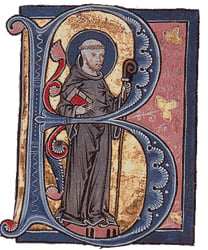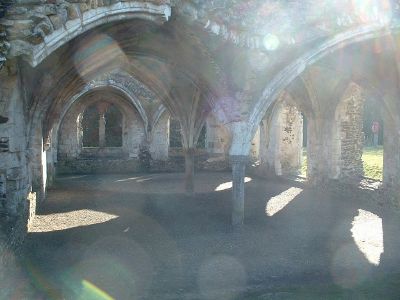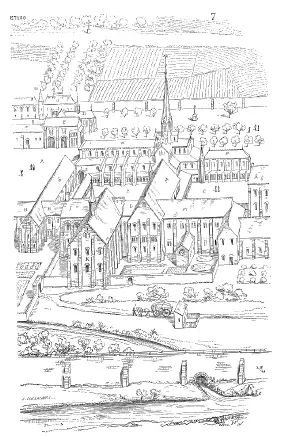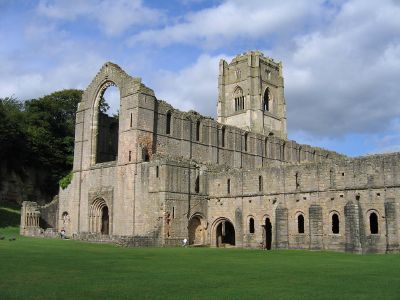Cistercians
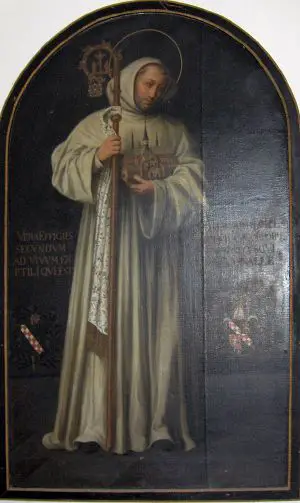
The Order of Cistercians (OCist; Latin: Cistercienses), sometimes called the White Monks (from the color of their habit, over which a black scapular or apron is sometimes worn) is a Roman Catholic religious order of enclosed monks. The first Cistercian Abbey was founded by Robert of Molesme (c. 1028â1111 C.E.) in 1098 C.E., at CĂźteaux Abbey. Two other individuals, Saint Alberic of Citeaux and Saint Stephen Harding, are considered co-founders of the order, and Bernard of Clairvaux (1090â1153 C.E.) is associated with the fast spread of the order during the twelfth century.
The keynote of Cistercian life is a return to a literal observance of the Rule of Saint Benedict, rejecting the perceived laxity of mainstream Benedictine practice. They believed that the Benedictines had become complacent in their monastic practice, and wanted to go back to reproduce monastic life exactly as it had been in Saint Benedict's time. The most striking feature in the reform was the return to manual labor, and especially to field-work, which became a special characteristic of Cistercian life. The Cistercians became the main force of technological diffusion in medieval Europe.
The Cistercians were badly affected by the Protestant Reformation, the Dissolution of the Monasteries under King Henry VIII, the French Revolution, and the revolutions of the eighteenth century, but some survived and the order recovered in the nineteenth century. Today the Cistercians are divided into three bodies: the "Common Observance," the "Middle Observance," and the "Strict Observance" (Trappists).
History
Foundation
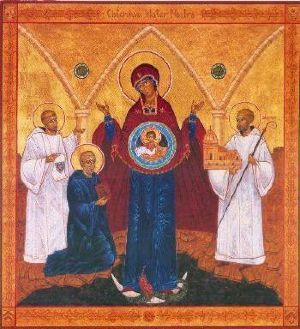
In 1098 C.E., a band of 21 Cluniac monks left their abbey of Molesme in Burgundy and followed their Abbot, Robert of Molesme (1027-1111), to establish a new monastery. The group was looking to cultivate a monastic community in which monks could carry out their lives in stricter observance of the Rule of Saint Benedict. On March 21, 1098, the small faction acquired a plot of marsh land just south of Dijon called CĂźteaux (Latin: "Cistercium"), given to them expressly for the purpose of founding their Novum Monasterium.[1]
During the first year the monks set about constructing lodging areas and farmed the lands. In the interim, there was a small chapel nearby which they used for Mass. Soon the monks in Molesme began petitioning Pope Urban II to return their abbot to them. The case was passed down to Archbishop Hugues who passed the issue on down to the local bishops. Robert was then instructed to return to his position as abbot in Molesme, where he remained for the rest of his days. A good number of the monks who helped found CĂźteaux returned with him to Molesme, so that only a few remained. The remaining monks elected Prior Alberic as their abbot, under whose leadership the abbey would find its grounding. Robert had been the idealist of the order, and Alberic was their builder.
Upon assuming the role of abbot, Alberic moved the site of the fledgling community near a brook a short distance away from the original site. Alberic discontinued the use of Benedictine black garments in the abbey and clothed the monks in white cowls (undyed wool). He returned the community to the original Benedictine ideal of work and prayer, dedicated to the ideal of charity and self sustenance. Alberic also forged an alliance with the Dukes of Burgundy, working out a deal with Duke Odo the donation of a vineyard (Meursault) as well as stones with which they built their church. The church was sanctified and dedicated to The Virgin Mary on November 16, 1106 by the Bishop of Chalon sur SaĂŽne.[2]
On January 26, 1108 Alberic died and was soon succeeded by Stephen Harding, the man responsible for carrying the order into its crucial phase. Stephen created the Cistercian constitution, called Carta Caritatis (the Charter of Charity). Stephen also acquired farms for the abbey in order to ensure its survival and ethic, the first of which was Clos Vougeot. He handed over the west wing of the monastery to a large group of lay brethren to cultivate the farms.
Polity
The lines of the Cistercian polity were demarcated by Alberic, but it received its final form at a meeting of the abbots in the time of Stephen Harding, when was drawn up the Carta Caritatis.[3] a document which arranged the relations between the various houses of the Cistercian order, and exercised a great influence also upon the future course of western monasticism. From one point of view, it may be regarded as a compromise between the primitive Benedictine system, in which each abbey was autonomous and isolated, and the complete centralization of Cluny Abbey, where the abbot of Cluny was the only true superior in the body. Citeaux, on the one hand, maintained the independent organic life of the houses. Each abbey had its own abbot, elected by its own monks; its own community, belonging to itself and not to the order in general; its own property and finances administered by itself, without interference from outside.
On the other hand, all the abbeys were subjected to the general chapter, which met yearly at CĂźteaux, and consisted of the abbots only: the abbot of CĂźteaux was the president of the chapter and of the order, and the visitor of each and every house, with a predominant influence and the power of enforcing everywhere exact conformity to CĂźteaux in all details of the exterior life observance, chant, and customs. The principle was that CĂźteaux should always be the model to which all the other houses had to conform. In case of any divergence of view at the chapter, the side taken by the abbot of CĂźteaux was always to prevail.[4]
Spread
By 1111 C.E., the ranks had grown sufficiently at Cßteaux and Stephen sent a group of 12 monks to start a "daughter house," a new community dedicated to the same ideals of the strict observance of Saint Benedict. It was built in Chalon sur SaÎne in La Ferté on May 13, 1113.[5] Also, in 1113 C.E., Bernard of Clairvaux arrived at Cßteaux with 30 others to join the monastery. In 1114 C.E., another daughter house was founded, Pontigny Abbey. Then in 1115 C.E., Bernard founded Clairvaux, followed by Morimond in the same year. Then Preuilly, La Cour-Dieu, Bouras, Cadouin and Fontenay, were likewise established. At Stephen's death in 1134, there were over 30 Cistercian daughter houses; at Bernard's death in 1154, there were over 280; and by the end of the century there were over 500 daughter houses. Meanwhile, the Cistercian influence in the Roman Catholic Church more than kept pace with this material expansion, so that St Bernard saw one of his monks ascend the papal chair as Pope Eugene III.
By the end of the twelfth century the Cistercian houses numbered around 500; in the thirteenth century a hundred more were added; and at its height in the fifteenth century, the order would be close on 750 houses.
Nearly half of the houses had been founded, directly or indirectly, from Clairvaux, so great was Saint Bernard's influence and prestige: indeed he has come almost to be regarded as the founder of the Cistercians, who have often been called Bernardines. The order was spread all over western Europe, chiefly in France, but also in Germany, Bohemia, Moravia, Silesia, England, Wales, Scotland, Ireland, Italy (where the Certosa di Pavia is their most famous edifice), Sicily, Poland, Hungary, Romania (Kerz), Norway, Sweden, Spain and Portugal, where some of the houses, like the Monastery of Alcobaça, were of almost incredible magnificence. One of the most important libraries of the Cistercians was in Salem, Germany.
Monastic life and technological diffusion
The keynote of Cistercian life was a return to a literal observance of Saint Benedict's rule: how literal may be seen from the controversy between Saint Bernard and Peter the Venerable, abbot of Cluny.[6] The Cistercians rejected alike all mitigations and all developments, and tried to reproduce the life exactly as it had been in Saint Benedict's time, indeed in various points they went beyond it in austerity. The most striking feature in the reform was the return to manual labor, and especially to field-work, which became a special characteristic of Cistercian life.
To make time for this work they cut away the accretions to the divine office that had been steadily growing during three centuries, and which in Cluny and the other Benedictine monasteries had come to exceed greatly in length the regular canonical office.
It was as agriculturists and horse and cattle breeders that, after the first blush of their success and before a century had passed, the Cistercians exercised their chief influence on the progress of civilization in the later Middle Ages: they were the great farmers of those days, and many of the improvements in the various farming operations were introduced and propagated by them, and it is from this point of view that the importance of their extension in northern Europe can be estimated.
At the beginning, the Cistercians renounced all sources of income arising from benefices, tithes, tolls and rents, and depended for their income wholly on the land. This developed an organised system for selling their farm produce, cattle and horses, and notably contributed to the commercial progress of the countries of western Europe. With the foundation of Waverley Abbey in 1128, the Cistercians spread to England, and many of the most beautiful monastic buildings of the country, beautiful in themselves and beautiful in their sites, were Cistercian, as seen in Tintern Abbey, Rievaulx Abbey, Byland Abbey and Fountains Abbey. A hundred were established in England in the next hundred years, and then only one more up to the Dissolution. Thus by the middle of the thirteenth century, the export of wool by the English Cistercians had become a feature in the commerce of the country.
In Spain, one of the earliest surviving Cistercian houses - the Real Monasterio de Nuestra Senora de Rueda in the Aragon region - is a good example of early hydrologic engineering, using a large waterwheel for power and an elaborate hydrological circulation system for central heating.
Farming operations on so extensive a scale could not be carried out by the monks alone, whose choir and religious duties took up a considerable portion of their time; and so from the beginning the system of lay brothers was introduced on a large scale. The lay brothers were recruited from the peasantry and were simple uneducated men, whose function consisted in carrying out the various fieldworks and plying all sorts of useful trades: they formed a body of men who lived alongside of the choir monks, but separate from them, not taking part in the canonical office, but having their own fixed round of prayer and religious exercises.
A lay brother was never ordained, and never held any office of superiority. It was by this system of lay brothers that the Cistercians were able to play their distinctive part in the progress of European civilization. However, it often happened that the number of lay brothers became excessive and out of proportion to the resources of the monasteries, there being sometimes as many as 200, or even 300, in a single abbey. On the other hand, at any rate in some countries, the system of lay brothers in course of time worked itself out; thus in England by the close of the fourteenth century it had shrunk to relatively small proportions, and in the fifteenth century the régime of the English Cistercian houses tended to approximate more and more to that of the Black Monks (Benedictines).
Later history
The first Cistercian abbey in Bohemia was founded in Sedlec near KutnĂĄ Hora in 1158. In the late thirteenth and early fourteenth centuries, the Cistercian order played an essential role in the politics and diplomacy of the late PĆemyslid and early Luxembourg state, as reflected in the Chronicon Aulae Regiae, a chronicle written by Otto and Peter of Zittau, abbots of the Zbraslav abbey (Latin: Aula Regia, i.e., Royal Hall; today situated on the southern outskirts of Prague), founded in 1292 by the king of Bohemia and Poland, Wenceslas II. The order also played the main role in the early Gothic art of Bohemia; one of the outstanding pieces of Cistercian architecture is the Alt-neu Shul, Prague.
Knowledge of certain technological advances was transmitted by the order, and the Cistercians are known to have been skilled metallurgists.[7] According to Jean Gimpel, their high level of industrial technology facilitated the diffusion of new techniques: "Every monastery had a model factory, often as large as the church and only several feet away, and waterpower drove the machinery of the various industries located on its floor."[8] Iron ore deposits were often donated to the monks along with forges to extract the iron, and within time surpluses were being offered for sale. The Cistercians became the leading iron producers in Champagne, France, from the mid-thirteenth century to the seventeenth century, also using the phosphate-rich slag from their furnaces as an agricultural fertilizer.[9]
For a hundred years, till the first quarter of the thirteenth century, the Cistercians supplanted Cluny as the most powerful order and the chief religious influence in western Europe. In 1335, Pope Benedict XII, himself a Cistercian, had promulgated a series of regulations to restore the primitive spirit of the order. However, their influence began to wane, chiefly, no doubt, because of the rise of the mendicant orders, who ministered more directly to the needs and ideas of the new age.
Additionally, some of the reasons of Cistercian decline were internal. For instance, there was the permanent difficulty of maintaining in its first fervor a body embracing hundreds of monasteries and thousands of monks, spread all over Europe; and as the Cistercian very raison d'ĂȘtre consisted in its being a reform, a return to primitive monachism, with its field-work and severe simplicity, any failures to live up to this ideal worked against the raison-d'etre of the Cistercians.
Relaxations were gradually introduced in regard to diet and to simplicity of life, and also in regard to the sources of income, rents and tolls being admitted and benefices incorporated, as was done among the Benedictines; the farming operations tended to produce a commercial spirit; wealth and splendor invaded many of the monasteries, and the choir monks abandoned field-work.
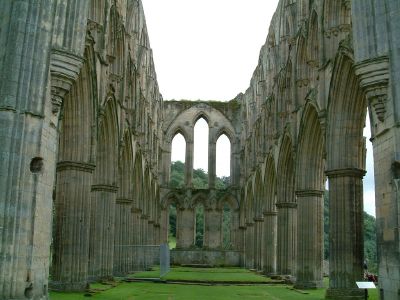
The later history of the Cistercians is largely one of attempted revivals and reforms. The general chapter for long battled bravely against the invasion of relaxations and abuses.
The English Reformation was disastrous for the Cistercians in England, as Henry VIII's Dissolution of the Monasteries saw the confiscation of church land throughout the country. Laskill, an outstation of Rievaulx Abbey and the only medieval blast furnace so far identified in Great Britain, was the one of the most efficient blast furnaces of its time.[7] Slag from contemporary furnaces contained a substantial concentration of iron, whereas the slag of Laskill was low in iron content, and is believed to have produced cast iron with efficiency similar to a modern blast furnace.[10][11] The monks may have been on the verge of building dedicated furnaces for the production of cast iron,[7] but the furnace did not survive Henry's Dissolution in the late 1530s, and the type of blast furnace pioneered there did not spread outside Rievaulx. An agreement (immediately after that) concerning the 'smythes' with the Earl of Rutland in 1541 refers to blooms.[12] Some historians believe that the suppression of the English monasteries may have stamped out an industrial revolution.[7]
After the Protestant Reformation
The sixteenth century saw the rise of the Feuillants, which spread widely in France and Italy, in the latter country under the name of "Improved Bernardines." The French congregation of Sept-Fontaines (1654) also deserves mention. In 1663 de Rancé reformed La Trappe.
In the seventeenth century, a great effort at a general reform was made, promoted by the pope and the king of France; the general chapter elected Richelieu (commendatory) abbot of CĂźteaux, thinking he would protect them from the threatened reform. In this they were disappointed, for he threw himself wholly on the side of reform. So great, however, was the resistance, and so serious the disturbances that ensued, that the attempt to reform CĂźteaux itself and the general body of the houses had again to be abandoned, and only local projects of reform could be carried out.
Modern Period
The Protestant Reformation, the ecclesiastical policy of Joseph II (1741â90), Holy Roman emperor, the French Revolution, and the revolutions of the eighteenth century, almost wholly destroyed the Cistercians; but some survived, and since the beginning of the last half of the nineteenth century there has been a considerable recovery. Gandhi visited a Trappist abbey near Durban in 1895 and wrote an extensive description of the order.
At the beginning of twentieth century, the Cistercians were divided into three bodies:
- The Common Observance, with about 30 monasteries and 800 choir monks, the large majority being in Austria-Hungary; they represent the main body of the order and follow a mitigated rule of life; they do not carry on field-work, but have large secondary schools, and are in manner of life little different from fairly observant Benedictine Black Monks; of late, however, signs are not wanting of a tendency towards a return to older ideals;
- The Middle Observance, embracing some dozen monasteries and about 150 choir monks;
- The Strict Observance, or Trappists, with nearly 60 monasteries, about 1600 choir monks and 2000 lay brothers.
Today, there are about 100 Cistercian monasteries and about 4700 monks, including lay brothers. There has always been a large number of Cistercian nuns; the first nunnery was founded at Tart in the diocese of Langres, 1125; at the period of their widest extension there are said to have been 900 nunneries, and the communities were very large. The nuns were devoted to contemplation and also did field-work. The best known of all Cistercian convents was probably Port-Royal, reformed by Angélique Arnaud, and associated with the story of the Jansenist controversy. After all the troubles of the 19th century there still exist 100 Cistercian nunneries with 3000 nuns, choir and lay; of these, 15 nunneries with 900 nuns are Trappist.
Monasteries
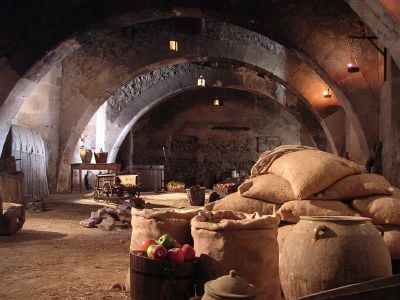
Australia
- Tarrawarra Abbey, Victoria, Australia
Europe
- Abbey of Loc-Dieu, France (closed 1793)
- Abbey of SĂ©nanque, Gordes, France
- LĂ©rins Abbey, Saint-Honorat, France
- Mazan Abbey, France (closed during the French Revolution)
- Certosa di Pavia, northern Italy, built from 1396
- Zinna Abbey in JĂŒterbog, Germany
- Lehnin Abbey in Brandenburg, Germany
- Fountains Abbey (ruin), Yorkshire, England
- Cleeve Abbey (ruin), Somerset, England
- Mount St. Bernard Abbey Leicestershire, England
- Tintern Abbey (ruin), English/Welsh border region
- Abbeycwmhir Wales (ruin) (closed before Dissolution of the Monasteries)
- Strata Florida Abbey (ruin) Mid Wales
- Caldey Island, Pembroke, Wales
- Balmerino Abbey, Fife, Scotland
- Mount Melleray Abbey, Co. Waterford, Ireland (Trappist)
- Mount St. Joseph Abbey, Roscrea, Ireland
- Bective Abbey, Co. Meath, Ireland
- Portglenone Abbey Church, County Antrim, Northern Ireland
- Heiligenkreuz Abbey, Austria
- Lilienfeld Abbey, Austria
- Zwettl Abbey, Austria
- Wurmsbach Abbey, Switzerland
- Zirc Abbey, Hungary
- Belakut Abbey established 1235, demolished 1688. Medieval Hungary (Today in Serbia)
- Petrovaradin, Vojvodina, Serbia (ruins)
- CĂąrĆŁa Monastery, Sibiu county, Romania
- KoĆbacz, Poland
- Cistercians Abbey in SulejĂłw, Poland
- KrzeszĂłw Abbey, Poland
- Ascension of Our Lady, Hohenfurth (VyĆĄĆĄĂ Brod), Czech republic
- Cistercian Abbey StiÄna, Slovenia, established in 1132
- Orval Abbey, Gaume region of Belgium
- Westmalle Abbey, Westmalle, Belgium
- Bornem Abbey (Belgium)
- Our Lady the Royal of Las Huelgas Abbey, Valladolid, Spain
- Our Lady the Royal of Villamayor de los Montes Abbey, Burgos, Spain
- Our Lady of Bujedo de Juarros Abbey, Burgos, Spain
- Real Monasterio de Nuestra Senora de Rueda, Ebro river, norther Spain
- Poblet| Poblet monastery, Catalonia, Spain (UNESCO World Heritage Site)
- Monasterio Santa MarĂa de ValdediĂłs, Asturias, Spain
- Monastery of Alcobaça, Portugal (UNESCO World Heritage Site)
- SorĂž Klosterkirke, SorĂž, Denmark
- Alvastra Abbey, Sweden (closed 1530, partially demolished)
- Varnhem Abbey, Sweden (church still remains, closed during Gustav I reformation)
- Lyse kloster, Norway, established 1146, closed 1537.
- Tautra Mariakloster, Norway, reopened 1999, autonomy 2006
New Zealand
- Southern Star Abbey, Kopua, New Zealand
United States
- Our Lady of Dallas Abbey, Irving, Texas
- Cistercian Monastery, Mount Laurel, New Jersey (Common Observance)
- Abbey of the Genesee, Piffard, New York (Trappist)
- Abbey of Gethsemani, Trappist, Kentucky (Trappist)
- St. Joseph Abbey, Spencer Massachusetts (Trappist)
- Mount Saint Mary's Abbey, Wrentham Massachusetts (Cistercian Nuns)
- Abbey of the Holy Spirit, Conyers, Georgia (Trappist)
- Abbey of New Clairvaux, Vina, California (Trappist)
- New Melleray Abbey, near Peosta, Iowa (Trappist)
- Mepkin Abbey, Moncks Corner, South Carolina. (Trappist)
- Snowmass Monastery, Snowmass, Colorado (Trappist)
- Lady of Spring Bank Cistercian Abbey, Sparta, Wisconsin
- Valley of Our Lady Monastery, Cistercian Nuns, Prairie du Sac, Wisconsin
Notes
- â Stephen Tobin, The Cistercians: Monks and Monasteries in Europe (The Herbert Press, LTD, 1995, ISBN 187156980X), 29, 33, 36.
- â Tobin, 37-38.
- â Jacques Paul Migne, Patrologia Latina clxvi. 1377.
- â Francis Aidan Gasquet, Sketch of Monastic Constitutional History, xxxv-xxxviii, prefixed to English trans. of Montalembert's Monks of the West, (ed. 1895).
- â Tobin, 46.
- â Samuel Maitland, Dark Ages (1844), § xxii.
- â 7.0 7.1 7.2 7.3 Thomas Woods, How the Catholic Church Built Western Civilization (Washington, DC: Regnery Publishing, Inc., 2005, ISBN 0895260387).
- â Jean Gimpel, The Medieval Machine: The Industrial Revolution of the Middle Ages (New York: Penguin, 1976), 67.
- â Gimpel, 68.
- â R.W. Vernon, G. McDonnell and A. Schmidt, An integrated geophysical and analytical appraisal of early iron-working: three case studies Historical Metallurgy 31(2) (1998), 67-81. Retrieved May 28, 2021.
- â David Derbyshire, Henry 'Stamped Out Industrial Revolution' The Daily Telegraph, June 21, 2002. Retrieved May 28, 2021.
- â H.R. Schubert, History of the British iron and steel industry from c. 450 B.C.E. to AD 1775 (London: Routledge, 1957), 395-397.
ReferencesISBN links support NWE through referral fees
- De Waal, Esther. The Way of Simplicity: The Cistercian Tradition. (Traditions of Christian Spirituality) Orbis Books, 1998. ISBN 978-1570751950
- Gasquet, Francis Aidan. English Monastic Life. (original 1904) Kessinger reprint ed. 2003. ISBN 0766162680
- Gimpel, Jean. The Medieval Machine: The Industrial Revolution of the Middle Ages. New York: Penguin, 1976
- Leroux-Dhuys, Jean-Francois. CISTERCIAN ABBEYS: HISTORY AND ARCHITECTURE. Konemann, 2006. ISBN 978-3833120770
- Maitland, Samuel. The Dark Ages: Essays Illustrating The State Of Religion And Literature In The Ninth, Tenth, Eleventh And Twelfth Centuries. (original 1844) Kessinger Reprint ed. 2007. ISBN 0548052239
- Matarasso, Pauline M. The Cistercian World: Monastic Writings of the Twelfth Century. Penguin Classics, 1993. ISBN 978-0140433562
- de Montalembert, Charles Forbes. The Monks of the West: From St. Benedict To St. Bernard V1 (original 1895) Kessinger Reprint ed. 2006. ISBN 1425490743
- Schubert, H.R. History of the British iron and steel industry from c. 450 B.C.E. to AD 1775. London: Routledge, 1957.
- Tobin, Stephen. The Cistercians: Monks and Monasteries in Europe. The Herbert Press, LTD, 1995. ISBN 187156980X
- Woods, Thomas E., Jr. How the Catholic Church Built Western Civilization. Washington, DC: Regnery Publishing, Inc., 2005. ISBN 0895260387
- This article incorporates text from the EncyclopĂŠdia Britannica Eleventh Edition, a publication now in the public domain.
External links
All links retrieved December 10, 2023.
- Bernardine Cistercians of Esquermes
- Order of Cistercians of the Strict Observance
- Stift Heiligenkreuz - The oldest surviving Cistercian monastery in Austria
- Tarrawarra Abbey - Cistercians in Australia
Credits
New World Encyclopedia writers and editors rewrote and completed the Wikipedia article in accordance with New World Encyclopedia standards. This article abides by terms of the Creative Commons CC-by-sa 3.0 License (CC-by-sa), which may be used and disseminated with proper attribution. Credit is due under the terms of this license that can reference both the New World Encyclopedia contributors and the selfless volunteer contributors of the Wikimedia Foundation. To cite this article click here for a list of acceptable citing formats.The history of earlier contributions by wikipedians is accessible to researchers here:
The history of this article since it was imported to New World Encyclopedia:
Note: Some restrictions may apply to use of individual images which are separately licensed.
